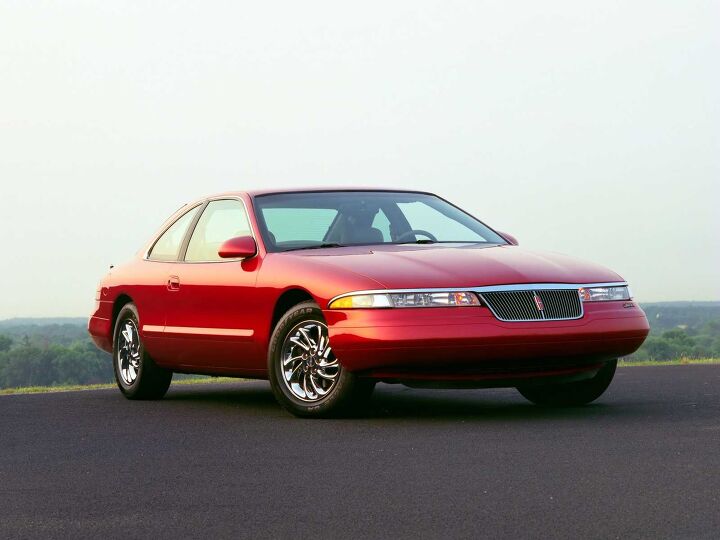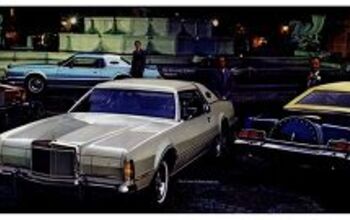Rare Rides Icons: The Lincoln Mark Series Cars, Feeling Continental (Part XLII)

We bid a sad farewell to the Mustang-adjacent Mark VII in our last installment. The first Continental Mark to adopt modern styling and disconnect itself from the Mark III of 1968 was also the last of its kind to wear a Continental badge. And as Lincoln sought to clarify its product lineup by separating the Continental sedan and allowing the Mark to stand on its own, the company also attempted to bring in a new, sportier customer. And that customer became the target at which the Mark VIII was aimed.
By the end of the Mark VII’s run in 1992, the outdated model sold a measly 5,732 examples. Throughout its (too long) tenure, the model dropped almost all notions of the increasingly irrelevant Designer Edition models. Bill Blass became the de facto base trim should a customer not want the sportier image of the only other option, LSC. There was little difference between the two by the end as the Blass adopted LSC features and power. Only trim remained to tell them apart.
Ford was well aware in the Eighties how the two-door market (especially at the luxury end) was in flux. There were simply fewer coupe buyers as Americans ran to minivans and the earliest family-friendly SUVs. By the mid-Eighties when the Mark, Cougar, and Thunderbird were on sale with Fox platform underpinnings, Ford began preparations for their successors.
All three cars would again reside on the same platform by the latter portion of the Eighties and well into the Nineties. In 1984 when the Mark VII was newly on sale, Corporate Program #12 was launched. The idea behind its goal, the new MN12 platform, was to pitch the Cougar and Thunderbird more upmarket and compete with one of the lone bright spots in two-door sales: European marques.
As all domestic manufacturers believed between 1982 and 2010 or so, the European car was more sophisticated, had better performance and handling, and in general a more desirable customer base than a domestic car. The Fox versions of the Mark, Cougar, and Thunderbird were conceived at a time when appealing to the sportier, Euro-angled customer was in its infancy. But by the time MN12 was in development, the fervor at capturing and converting the European intender to a domestic increased considerably.
Since it was the Eighties, one of the most coveted manufacturers that produced the best stuff was BMW. Thus Ford decided Thunderbird and Cougar would compete with two-doors from Bavaria, but at the same price point as they’d always occupied. The Seventies Fox platform just wouldn’t cut it for these new upmarket purposes.
The MN12 project was up and running by 1986 with a dedicated program manager, Tony Kutcha. The important decision to keep the platform rear-drive was made early on, as Ford diverged from GM’s approach of making almost all its passenger cars front-drive from 1985 onward. For performance reasons the MN12 was also developed with an independent rear suspension. Ford felt such a development was required in order for the new coupes to be taken seriously. In those days, the only other domestic rear-drive car with an independent suspension was the Corvette.
Though the project was already very costly, Ford explored another possibility that could have been an (expensive) game changer moment. Engineers thought it might be a good idea to add all-wheel drive to the MN12, at a time when the only companies doing so for passenger cars were bit players Subaru and Audi. Porsche was contracted to do some feasibility work for AWD, and we can all picture a Thunderbird SC Quattro right about now. But the idea was scrapped, as it was decided the development would be too costly.
The MN12 was finalized with a 113-inch wheelbase, and put into production on the 10th generation Ford Thunderbird and seventh generation Mercury Cougar for the 1989 model year. Both cars were much more aerodynamic and modern looking than the outgoing models. They were a bit shorter overall, but had a generous nine-inch increase in their wheelbase. Losing those massive overhangs was the way to a more sporty looking car.
It’s reported the Mark VIII variant of the MN12 project was supposed to enter production in 1990. This timeline checks out since it follows Thunderbird and Cougar by a year, which was the methodology for the Mark VII release. But it was a tumultuous time in the design department, and Lincoln was determined to outdo the coupe competition and not screw it up (like the Mark VI). Delays ensued, and the Mark VII was pushed back to a November 1992 introduction date for the ‘93 model year.
During the delays, Ford’s engineers made “some changes” to the MN12 in order to declare the Mark VIII rode on its own, independent platform. It had been quite some time (1979) since any Mark used its own platform, and in that instance it was only because the Thunderbird had moved to a new platform via downsizing. But the Mark VIII would be different, special.
The “independent” platform was called FN10. It shared the same wheelbase as the MN12, but there were some additional uses of aluminum in the chassis for weight saving purposes. The only other major difference was the placement of the gas tank, which was slightly relocated for Mark VIII usage. Said relocation required a revision to the exhaust routing. And that was all. Underpinnings bolted between these different platform cars perfectly.
Aside from its platform differentiated by small alterations nobody could see, Lincoln’s team had their work cut out for them as they attempted to differentiate the Mark from the Thunderbird and Cougar. Aside from the Mark’s sleek looks, that was largely achieved via mechanical and technological upgrades. Most exciting among them was an all-new and sophisticated V8 engine that was not shared with its lesser siblings or even other company vehicles, initially. We’ll talk about facts, figures, and engines next time.
[Images: Ford]
Become a TTAC insider. Get the latest news, features, TTAC takes, and everything else that gets to the truth about cars first by subscribing to our newsletter.

Interested in lots of cars and their various historical contexts. Started writing articles for TTAC in late 2016, when my first posts were QOTDs. From there I started a few new series like Rare Rides, Buy/Drive/Burn, Abandoned History, and most recently Rare Rides Icons. Operating from a home base in Cincinnati, Ohio, a relative auto journalist dead zone. Many of my articles are prompted by something I'll see on social media that sparks my interest and causes me to research. Finding articles and information from the early days of the internet and beyond that covers the little details lost to time: trim packages, color and wheel choices, interior fabrics. Beyond those, I'm fascinated by automotive industry experiments, both failures and successes. Lately I've taken an interest in AI, and generating "what if" type images for car models long dead. Reincarnating a modern Toyota Paseo, Lincoln Mark IX, or Isuzu Trooper through a text prompt is fun. Fun to post them on Twitter too, and watch people overreact. To that end, the social media I use most is Twitter, @CoreyLewis86. I also contribute pieces for Forbes Wheels and Forbes Home.
More by Corey Lewis
Latest Car Reviews
Read moreLatest Product Reviews
Read moreRecent Comments
- GregLocock Car companies can only really sell cars that people who are new car buyers will pay a profitable price for. As it turns out fewer and fewer new car buyers want sedans. Large sedans can be nice to drive, certainly, but the number of new car buyers (the only ones that matter in this discussion) are prepared to sacrifice steering and handling for more obvious things like passenger and cargo space, or even some attempt at off roading. We know US new car buyers don't really care about handling because they fell for FWD in large cars.
- Slavuta Why is everybody sweating? Like sedans? - go buy one. Better - 2. Let CRV/RAV rust on the dealer lot. I have 3 sedans on the driveway. My neighbor - 2. Neighbors on each of our other side - 8 SUVs.
- Theflyersfan With sedans, especially, I wonder how many of those sales are to rental fleets. With the exception of the Civic and Accord, there are still rows of sedans mixed in with the RAV4s at every airport rental lot. I doubt the breakdown in sales is publicly published, so who knows... GM isn't out of the sedan business - Cadillac exists and I can't believe I'm typing this but they are actually decent - and I think they are making a huge mistake, especially if there's an extended oil price hike (cough...Iran...cough) and people want smaller and hybrids. But if one is only tied to the quarterly shareholder reports and not trends and the big picture, bad decisions like this get made.
- Wjtinfwb Not proud of what Stellantis is rolling out?
- Wjtinfwb Absolutely. But not incredibly high-tech, AWD, mega performance sedans with amazing styling and outrageous price tags. GM needs a new Impala and LeSabre. 6 passenger, comfortable, conservative, dead nuts reliable and inexpensive enough for a family guy making 70k a year or less to be able to afford. Ford should bring back the Fusion, modernized, maybe a bit bigger and give us that Hybrid option again. An updated Taurus, harkening back to the Gen 1 and updated version that easily hold 6, offer a huge trunk, elevated handling and ride and modest power that offers great fuel economy. Like the GM have a version that a working mom can afford. The last decade car makers have focused on building cars that American's want, but eliminated what they need. When a Ford Escape of Chevy Blazer can be optioned up to 50k, you've lost the plot.









































Comments
Join the conversation
Always liked these MN12 cars and the subsequent Lincoln variant. But Ford, apparently strapped for resources or cash, introduced these half-baked. Very sophisticated chassis and styling, let down but antiquated old pushrod engines and cheap interiors. The 4.6L Modular V8 helped a bit, no faster than the 5.0 but extremely smooth and quiet. The interior came next, nicer wrap-around dash, airbags instead of the mouse belts and refined exterior styling. The Supercharged 3.8L V6 was potent, but kind of crude and had an appetite for head gaskets early on. Most were bolted to the AOD automatic, a sturdy but slow shifting gearbox made much better with electronic controls in the later days. Nice cars that in the right color, evoked the 6 series BMW, at least the Thunderbird did. Could have been great cars and maybe should have been a swoopy CLS style sedan. Pretty hard to find a decent one these days.
Next up should DEFINITELY be the Cadillac Eldorado.
On the subject of Caddies, I saw a Lyriq in person for the first time a couple of days ago, and I'm changing my tune on its' styling. In person, it works quite well, and the interior is very nicely executed.